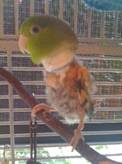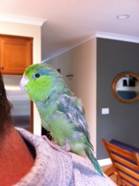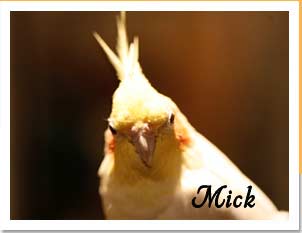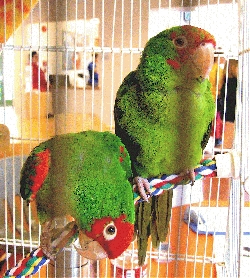Parrotlets! (or, Daisy, A Love Story)
By Renee Kochevar
 Daisy on her Daisy on herfirst day with me |
I’ve always loved animals and most living things – pretty much anything that wasn’t a poop-hurling monkey or a poisonous, creepy biting insect with stabbing prongs. I’m also not so fond of inhaling the random spider web or flying bug either. Nonetheless, animals are one of my greatest passions in life and I “ooh” and “aah” over every cantankerous, uncooperative Yorkie that happens to come close enough for me to pet. |
And although animals in general make me nutty with adoration, there is nothing like the cuteness factor of a parrotlet of which there are three genera: Nannopsittaca (Nannopsittaca panychlora, Tepui Parrotlet), Touit (Touit stictoptera, Spotwinged Parrotlet) and Forpus (Forpus coelestis, Pacific Parrotlet). Forpus = genus, coelestis = species. Of these three, my experience has been limited to the Pacific Parrotlet, also commonly known as the Celestial Parrotlet.
I have been the very lucky guardian to a number of parrotlets – the first I adopted from a breeder prior to my experience with Mickaboo. Since that first little beauty, I’ve had the pleasure of fostering and adopting a number of Pacifics – both males and females whose personalities have varied from my parrotlet Oji who thinks he’s a person; to the “pup-pups” (so named as they make a “pup-pup” clucking sound), a marauding couple bent on attacking any other bird as soon as they think they can get away with it; to my Kai-asaurus-rex who has the personality of, well, the name itself is self-explanatory. And then there’s Daisy.
For the past few years I’ve been Mickaboo’s unofficial Parrotlet Coordinator, and was recently asked to be the official coordinator to assist with the few parrotlet surrenders Mickaboo receives each year. One day I received an email asking if I could foster a little male parrotlet from the Sacramento area whose guardian decided that they could no longer take care of him. So, Pamela Lee, on one of her bird transfer trips, picked “him” up, temporarily named him Perry, and then met me in San Francisco so I could take him home to San Jose for quarantine.
Well, Perry was one of the saddest, baldest, most spastic little birds I’d ever seen. If the feather wasn’t gone entirely, it was raggedy, chewed and mutilated. But I knew when I saw Perry that “he” was a “she” as Pacifics have some sexual dimorphism. The males are a bit more colorful (they have more of a blue streak behind their eye and on their body) and the females tend toward more muted olive tones (and more docile personalities) – unless of course they are a colorful mutation. So, after a bit of thinking in the car on the way home my partner Gary and I named her Daisy. We named her this not because she looked like a flower, since she was mostly chicken skin and gray down feathers and looked more, well, “tumble-weedy”, but because we could see her demure, sweet personality and thought that the name Daisy just “fit”.
After living with us for a few months, Daisy claimed Gary as her own, doing her loud “Squawk! Squawk! Squawk! Squawk! Squawk! Squawk!” loudly, continuously, and interminably the second she heard his car come into the garage and until he went into the bird room to pick her up and put her on his collar to surreptitiously chew – Brooks Brothers or holey “bird” shirt - the cost and wearer’s intended use unimportant. Me she merely tolerates - for a limited period of time. Since I always get home from work first, I’ll take the birds out of their cages and bird room to run around the rest of the house and chew on most of my hard-earned belongings, while pooping on the rest, and I’ll take her along with the other birds that will let me. Approximately 45 minutes into our daily visit, she’ll start banging me on the back of my head while squawking. I ignore her hoping she’ll want to stay with me for a while longer and because I’m busy doing “stuff”, to which she’ll then escalate from back-of-the-head banging to pulling my hair. Hard. This means, “I want my snack NOW you Moron!” She’s always had these calm, appraising gray eyes and self-possessed demeanor that seem to say (to me only – Gary gets the adoring looks), “You really are a little bit stupid, aren’t you?”
And although Daisy is still a little “spaz” – she’s flighty (pun intended) - she’s discovered by letting her feathers grow a little bit she actually gets lift! When we take her out of her cage we’ll watch her “boing, boing, boing” around the room as she gets lift, then drops, then flaps really hard and gets a bit more lift, until she goes in for the ungainly, uncoordinated, if not crash, landing. Recently she’s become adept at the electric slide landing on the wood floors, and is starting to get the hang of landing on a narrow perch without falling off. Having her in our lives has been a joy – watching her become a bit more outgoing, a bit more demanding, and a bit more parrotlet-like (i.e., bossy) in personality. Her favorite thing for Gary to do is to gently scratch her jowls with his finger or his beard by rotating her head from one side to the other to make sure that both sides are equally addressed. In addition, one of her “go-to” actions is to stick her beak in Gary’s ear and say, “Raaaaa” when she wants something (usually petting or a snack) or if she’s upset. And I do mean that she’ll reach over, stick her beak right in his ear and do her little roar. How did she learn that a sound put into a human ear resulted in something being heard?
We’ve discovered that although she’s no longer bald, and she still chews off many of her feathers bit by bit (she’s still a little nervous bird), that she at least keeps her gray “sweater vest” now (her down feathers) until the next round of feathers appear. So, as time progresses, we see her becoming happier, less nervous and more well-adjusted since she’s joined our family flock (people included) – forward two steps, one back, but thankfully always moving forward. From the moment we laid eyes on her, “Daisy-Do” (aka, Daisy-Doopey and Daisy-Girl) has had our hearts in the palm of her giant (for a parrotlet) feet. For such a little bird (20 grams), she’s got REALLY BIG feet – our increasingly feathered Daisy-Do! |

Daisy Now! |

